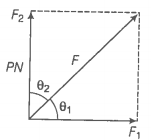A body of mass \(10 ~\text{Kg}\) is acted upon by two perpendicular forces, \(6 ~\text{N}\) and \(8 ~\text{N}\). The resultant acceleration of the body is:
| (a) | \(1~\text{ms}^{-2}\) at an angle of \(\text {tan}^{-1} \left(\dfrac{4}{3}\right ) \) w.r.t. \(6 ~\text{N}\) force. |
| (b) | \(0.2~\text{ms}^{-2}\) at an angle of \(\text {tan}^{-1} \left(\dfrac{3}{4}\right ) \) w.r.t. \(8 ~\text{N}\) force. |
| (c) | \(1~\text{ms}^{-2}\) at an angle of \(\text {tan}^{-1} \left(\dfrac{3}{4}\right ) \) w.r.t. \(8 ~\text{N}\) force. |
| (d) | \(0.2~\text{ms}^{-2}\) at an angle of \(\text {tan}^{-1} \left(\dfrac{3}{4}\right ) \) w.r.t. \(6 ~\text{N}\) force. |


© 2025 GoodEd Technologies Pvt. Ltd.